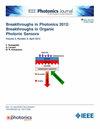单模 852 纳米法拉第激光器
IF 2.1
4区 工程技术
Q3 ENGINEERING, ELECTRICAL & ELECTRONIC
引用次数: 0
摘要
实现原子平移频率输出、单模、高频率稳定性、窄线宽半导体激光器,是量子精密测量和原子物理等量子相关领域的终极愿景之一。利用角立方体反向反射器作为反馈元件的 852 nm Cs 原子单模法拉第激光器被展示出来,并被称为角立方体反馈法拉第激光器。通过优化法拉第反常色散滤光片(FADOF)的工作参数,即使二极管电流从55 mA变化到155 mA(步长约2 mA),二极管工作温度从$11.8 \mathrm{^{\circ }C}$ 到 37.2 \mathrm{^{\circ }C}$ (增量约为 3.5 \mathrm{^{\circ }C}$)。此外,单模激光器的振荡可以在很大的角度范围内实现,特别是在 +3$\mathrm{^{\circ }}$ 和 -3$\mathrm{^{\circ }}$ 之间,其中角度被定义为入射光线与角立方体光轴的偏差。利用角立方逆反射器作为外腔反馈元件,可以将入射光束精确地反射回原来的方向,从而提高环境兼容性和可靠性。通过使用两个相同的激光器进行外差跳动测量,最可能的线宽为 8 kHz。在 155 mA 电流下,输出功率最大可达 57 mW。至于激光器的噪声性能,10 kHz 时相对强度噪声(RIN)的典型值低于-134 dBc/Hz。该激光器的帕色噪声优于商用产品。这种单模角立方反馈法拉第激光器可广泛用于量子精密测量,如原子钟、原子重力仪和原子磁力计等。本文章由计算机程序翻译,如有差异,请以英文原文为准。
A Single-Mode 852-nm Faraday Laser
Realizing always atomic translation frequency output, single-mode, high frequency stability, narrow linewidth semiconductor lasers, is one of the ultimate visions of areas related to quantums, such as quantum precision measurement and atomic physics. A single-mode Cs atom 852 nm Faraday laser, utilizing a corner cube retroreflector as the feedback element, is demonstrated and termed as a corner-cube-feedback Faraday laser. Its output frequency remains close to the Cs atomic Doppler-broadened transition line, and through the optimization of the working parameters of Faraday anomalous dispersion optical filter (FADOF), the laser output mode can still remain single, even though the diode current changes from 55 mA to 155 mA (with incremental step of approximately 2 mA) and the diode working temperature varies from
$11.8 \,\mathrm{^{\circ }C}$ $37.2 \,\mathrm{^{\circ }C}$ $3.5 \,\mathrm{^{\circ }C}$ $\mathrm{^{\circ }}$ $\mathrm{^{\circ }}$
求助全文
通过发布文献求助,成功后即可免费获取论文全文。
去求助
来源期刊

IEEE Photonics Journal
ENGINEERING, ELECTRICAL & ELECTRONIC-OPTICS
CiteScore
4.50
自引率
8.30%
发文量
489
审稿时长
1.4 months
期刊介绍:
Breakthroughs in the generation of light and in its control and utilization have given rise to the field of Photonics, a rapidly expanding area of science and technology with major technological and economic impact. Photonics integrates quantum electronics and optics to accelerate progress in the generation of novel photon sources and in their utilization in emerging applications at the micro and nano scales spanning from the far-infrared/THz to the x-ray region of the electromagnetic spectrum. IEEE Photonics Journal is an online-only journal dedicated to the rapid disclosure of top-quality peer-reviewed research at the forefront of all areas of photonics. Contributions addressing issues ranging from fundamental understanding to emerging technologies and applications are within the scope of the Journal. The Journal includes topics in: Photon sources from far infrared to X-rays, Photonics materials and engineered photonic structures, Integrated optics and optoelectronic, Ultrafast, attosecond, high field and short wavelength photonics, Biophotonics, including DNA photonics, Nanophotonics, Magnetophotonics, Fundamentals of light propagation and interaction; nonlinear effects, Optical data storage, Fiber optics and optical communications devices, systems, and technologies, Micro Opto Electro Mechanical Systems (MOEMS), Microwave photonics, Optical Sensors.
 求助内容:
求助内容: 应助结果提醒方式:
应助结果提醒方式:


